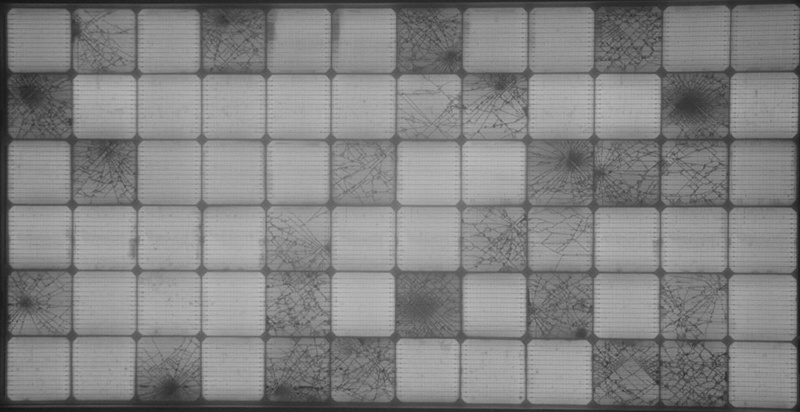
PV MODULE PERFORMANCE TEST
Analysis of the modules I-V characteristic, efficiency measurement and insulation, thermographic analysis.

DC INSULATION AND CONTINUITY TEST
Analysis and checks on the DC side of a plant. Verification of Continuity and Insulation Resistance.

COMPLETE TEST OF PHOTOVOLTAIC PLANT
Testing of an entire photovoltaic system. Measurement of global losses of the photovoltaic system.
![]()
FLUORESCENCE PV MODULE TEST
Pv module Fluorescence test on site, for cracks, EVA degradation and delamination detection.

PID POTENTIAL INDUCED DEGRADATION
PID (Potential Induced Degradation). Problem description and methods for photovoltaic modules testing.

PV MODULES ELECTRO LUMINESCENCE
Outdoor Electroluminescence on site for photovoltaic modules. Case studie and methodology.

PV PLANT DRONE THERMOGRAPHY
Execution of photovoltaic modules thermography with drone. Layout of thermal defects.

MODULES PID ONLINE CALCULATOR
Online PID Calculator. To perform an initial check for PID presence in your photovoltaic modules.
IN FIELD FLUORESCENCE OF MODULES AND PHOTOVOLTAIC STRINGS

We are able to offer the Fluorescence service of high resolution photovoltaic modules and strings for an easy identification of the photovoltaic modules affected by cell connection bus breakages, cell fractures (cracks and micro-cracks) , delamination, EVA degradation and much more.
WHAT IS AND HOW THE FLUORESCENCE TEST WORKS
An innovative technique used for the study of defects in photovoltaic modules is the Fluorescence test (FL). This method exploits the homonymous phenomenon of fluorescence which occurs thanks to the presence of some atoms present in the module's EVA. This technique can be used as a complementary technique of the electroluminescence for the identification of defects in module cells.
Unlike electroluminescence, this new technique does not require the modules or module strings to be disconnected from the plant inverter in order to be connected to a power supply. Analyzes performed outdoors on functioning systems produce FL images of excellent quality.
By fluorescence technique it is possible to find the following defects in the modules:
• Cell cracks and micro cracks;
• Parts of electrically insulated cells;
• Cells disconnected due to faulty electrical contacts;
• EVA degradation and delamination;
• much more;
The fluorescence technique is very often used for the assessment of damage from atmospheric agents on photovoltaic modules (eg Hailstorm). The following image shows an example of a photovoltaic module with cell crack due to impact from hailstorm.

As with the electroluminescence test, the fluorescence technique involves retrieving images in the dark. This constraint is due to the fact that solar radiation contains photons with a wavelength equal to that of UV rays which are those emitted during the fluorescence phenomenon. Therefore it is necessary to avoid that the UV rays contained in the solar radiation overlap with those emitted by the modules under test, staggering the results.

![]()
CONTACT US FOR TECHNICAL ANALYSIS OF YOUR PHOTOVOLTAIC PLANT
We are available for individuals and installers for technical inspection and expertise also for legal disputes use.
Contact us info@st-ingegneria.com



